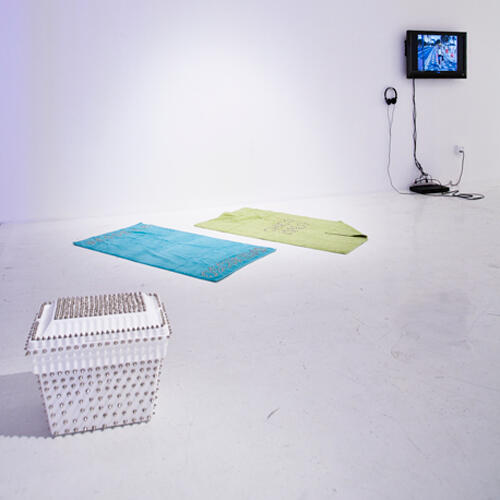Mayami Son Machín
Gallery Diet, Miami
Mayami Son Machín was, first and foremost, a fun exhibition and as is often the case with a good sense of humor, a keen commentary regarding our reality. The evident sense of pastiche in the title of the exhibition itself was the constant that guided Mayami Son Machín along its amusing scrutiny of the prejudices and clichés that identify Latino culture.
The exhibition was curated by Stefan Benchoam and Emiliano Valdés, founders of Proyectos Ultravioleta, an independent arts management organization with headquarters in Guatemala City that has been developing a praiseworthy task aimed at the promotion of Guatemalan contemporary art.

On the basis of the epitome of Miami’s Latino music in the 1980s, Mayami Son Machín proposed an exploration of Latino idiosyncrasy that took as its point of departure three critical aspects announced in the title of the exhibit itself. The first of these, “Mayami”, made reference to the enclave of Miami as the image of desire for Latin America: a stereotype of commercial fulfillment, a glamorous holiday resort; but also an evidence of the migratory problem faced by Latin America, the exponent of the political and social reality of our countries.
The “son” then participated as the second zone of inquiry. A musical genre distinctive of the region, the son incarnates its melodic and sensual aspects, and imposes the erotic and musical commentary associated to Latino culture, while the “Machín” alluded to the macho cliché and the gender role.
The general atmosphere of the exhibit recreated an idealized and stereotyped Miami where exotic birds glide over our heads amidst tropical punches, mating dogs, colorful hammocks, cool boxes and sunset views.
At the opening gala, Naufus Ramírez-Figueroa’s chocolate-covered bananas became a controversial snack, given the general mood of the show, contributing to the work a strong content of obvious erotic implications.
Also playing with sexual stereotypes, Chocorrol, 1997, stood out. In the video, Yoshua Okón presented two dogs at the very moment of copulating. The male was a Xoloitzcuintl (typical Mexican dog with a dark skin and no hair) while the female was a sophisticated French Poodle with white hair and a refined coiffure. Both dogs incarnate a scathing satire regarding moral standards and gender and class issues predominant in Latino culture. A new level of reading imposed itself when we discovered that the artist had paid for the services of the sophisticated bitch to satisfy his dog’s desire.
Occupying the gallery floor, Radames “Juni” Figueroa displayed his installation consisting of two beach towels on which the inscriptions “bad boy” and “darkness” could be read, and close to them, a cooler. The latter, made of disposable polyethylene and decorated with punk-style silvery metal spikes, created a highly suggestive aesthetics of the precarious and the kitsch. Amusing, incisive, glamorous, decadent, a little bit seriously, a little bit jokingly, Mayami Son Machín constituted an effective parody of the clichés associated to Latino culture and at the same time, a very good dose of good art.
-
 General view of Mayami Son Machín. In the foreground, installation by Radamés “Juni” Figueroa. Behind, Juan Pablo Echeverri. Photo courtesy of Diet Gallery. Vista general de Mayami Son Machín. En primer plano, instalación de Radamés "Juni" Figueroa. Atrás, Juan Pablo Echeverri. Foto cortesía Diet Gallery.
General view of Mayami Son Machín. In the foreground, installation by Radamés “Juni” Figueroa. Behind, Juan Pablo Echeverri. Photo courtesy of Diet Gallery. Vista general de Mayami Son Machín. En primer plano, instalación de Radamés "Juni" Figueroa. Atrás, Juan Pablo Echeverri. Foto cortesía Diet Gallery.




